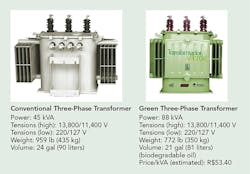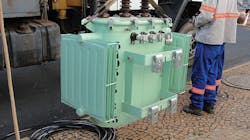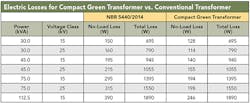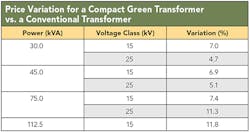Brazil R&D Project Transforms the Future
After 10 years of a research and development (R&D) project that included the evaluation and testing of new insulating materials to reduce production costs and provide a more efficient and environmentally friendly distribution transformer, the result is the transformador verde compacto, or the compact green transformer. This equipment was the result of the development of prototypes of distribution transformers and several studies in high-voltage laboratories to evaluate and determine the ratings, dimensions and overall performance.
In the first phase of the project, the aim was to develop prototypes of a compact distribution transformer, resulting in a vegetable oil (natural ester)-insulated transformer rated 88 kVA with the same size and dimensions of a 45-kVA conventional mineral oil unit. The second phase was dedicated to developing an industrial-scale production from the prototypes according to standard ratings. The final phrase focused on improving losses, efficiency and design optimization.
Satisfying Many Needs
The project team was confronted by a plethora of sometimes-conflicting distribution transformer needs: extend the service life, lessen the maintenance costs, reduce the failure rate, increase the supply quality and improve the availability. Of course, these needs drive the development of new materials, new criteria from electrical systems and new asset management concepts.
This R&D project was funded by Brazil’s Agência Nacional de Energia Elétrica R&D program from utilities of the CPFL Group, in a partnership with CGTI, Itaipu Transformadores and Cargill. The latter supplied the vegetable oil (natural ester) and was a partner through all phases of the R&D project.
The project took into consideration alternative oils featuring better oxidation stability, better heat transfer, extended service life, lower operating temperatures, higher thermal stability and lower maintenance cost. These were coupled with a higher biodegradability rate and reduced environmental impact.
In order to comply with all these requirements, the goal of the project was to develop a new distribution transformer using fluid and solid insulation materials already available on the market. Alternative insulation materials such as insulating papers made from polyaramids, and insulating oils from mixtures of polyalphaolefin and aromatic hydrocarbons, or made from vegetable oils, also were evaluated. The most viable technical and economical alternatives were identified.
The transformers were applied in a typical region to evaluate the performance in real-life field conditions. The result was a new distribution transformer that uses more efficient and environmentally compatible insulating materials while significantly reducing manufacturing and maintenance costs.
Life Span Extension
Currently, the life span of distribution transformers is approximately 20 years, depending on the load at which the transformers are specified. During the first year of this study, there was an assessment done about thermal efficiency solutions that could be applied in transformers, mainly through the use of new insulating oils. Data was gathered on the manufacturing procedures and methodologies currently applied in transformer design. The study investigated experiences and attempts to reduce production costs through efficiency gain as well as possible problems associated with the use of new materials.
During the next phase, performance of the insulating materials, selected through investigative tests in a chemical laboratory, were compared. The best solution was selected to be part of the distribution transformer prototype development, subsequently evaluated at a high-voltage laboratory to determine the ratings, dimensions and overall performance.
The compact three-phase transformer prototype, built in a 45-kVA transformer tank, had the following characteristics:
- Hybrid transformer with a normal core
- Power of 88 kVA
- Tensions of 13,800/11,400 V at high tension
- Tensions of 220/127 V at low tension
- Biodegradable oil of 21.4 gal (81 liters)
- Weight of 772 lb (350 kg)
- Total losses of 1969 W
- No-load losses of 236 W.
The approved prototypes, which served as a basis for the industrial-scale production, were those insulated with biodegradable, natural ester-based insulating fluid. The insulating paper used was conventional Kraft paper.
Lowest Cost per Kilovolt-Amp
Because the size and ratings of the new transformers (88 kVA) do not conform to existing ratings and standards, the new transformer was compared to the existing 45-kVA mineral oil unit; both have the same external dimensions and design. The new transformer losses were compared with a 75-kVA transformer, as it is the closest power rating available.
There was a substantial weight reduction, from 959 lb to 187 lb (435 kg to 85 kg), reducing the resources needed for equipment installation and maintenance, as well as requiring less mounting hardware (crosshead, bracket and screws). Along with the weight reduction was a reduction in the volume of oil used by the new transformer compared with the 75-kVA transformer, 27 gal (102 liters) of mineral oil versus 21 gal (81 liters) of vegetable oil.
The alterations made in the new transformer helped to reduce the price of the equipment, comparing the unit price of the kilovolt-amps of the existing 45-kVA transformer with the new price.
Production Scale
The original project did not show any noncompliance, and there were no malfunction or abnormal events. However, the team agreed a larger population was necessary for performance evaluation. Statistically, five transformers in a space of more than 180,000 units in operations at CPFL was an insignificant ratio.
In early 2007, an additional 250 units were installed in key critical points of the CPFL distribution grid. In the following years, the project or maintenance teams installed many more units, reaching a population of 5000 units.
Economic Analysis
Once the scale-production phase was concluded, the project started to develop a 75C° (105F°) temperature rise design. This explored the better thermal performance of the insulating vegetable oil versus the mineral oil, and aimed to reduce no-load losses while maintaining total losses.
The reduction of no-load losses has a significant impact on the utility technical losses because it is constant and has no relation to the transformer load. The savings generated by reducing no-load losses compensates for the higher initial cost of the compact green transformer over a span of just a few years. This allows justification of a higher initial purchase value.
The purchase price of a compact green transformer compared with that of a conventional mineral oil transformer is 5% to 12% higher because natural esters are used. A simulation was performed considering several ranges of transformer loading and their respective losses. A 75-kVA, 15-kV transformer was used as a basis for the simulation, as it presents a relevant quantity installed in the utilities of the CPFL Group.
After analyzing the reduction of losses versus loading, it was realized, for transformers with a low load factor, the loss reduction is higher, reaching 40% in some cases. These transformers are common in rural areas where no-load loss is more significant and its reduction generates large optimization gains with a faster return on investment (ROI).
Most transformers operate with a load factor of about 70%. Analysis led to the conclusion, for load factor of 65%, the reduction in losses is approximately 14% per 75-kVA transformer. The smaller the transformer load, the quicker the ROI when comparing the green transformer with the conventional mineral oil transformer.
The ROI time varies between approximately three years and six years, depending on the transformer load. Considering most distribution transformers operate with a load factor of 65%, the average time for ROI will be about four years.
The results of the economic analysis were encouraging for the compact green transformers. The ratings that presented the best ROI are also for the units with higher quantities installed in the CPFL grid. This analysis helps to guide the selection of transformers to be replaced in case of failure or asset depreciation.
Investing in Research
The overall result of this research effort — from production of the first prototypes to optimization of the final product — is a more compact, efficient and environmentally friendly distribution transformer. The compact green transformers are smaller and have significantly lower no-load losses while maintaining the original total losses.
Compatibility tests confirmed the suitability of the materials chosen, resulting in more robust equipment. The results of the electrical tests demonstrate that despite being compact, the compact green transformer presents better performance, can withstand higher temperature rises and, consequently, higher load.
The development of the compact green transformer through a R&D project shows the importance of investing in research, which contributed to the development of a new distribution transformer using conventional materials in addition to an insulating vegetable fluid with better thermal performance.
In 2014, the eight utilities formed by the CPFL Group converted to compact green transformers as their standard solution for new distribution transformer acquisition.
Vagner Vasconcellos ([email protected]) is an electrical engineer with CPFL Energia. He has more than 25 years of experience in power systems and is a graduate and postgraduate lecturer in the area of power systems. He holds BSEE and MSEE degrees and is pursuing a Ph.D. in electrical engineering.
José Mak ([email protected]) is the owner of Bueno & Mak Group, a utility consulting and engineering firm with a focus on innovation chain, and superintendent of the Institute of Sciences and Innovation Center for Management of Technology and Innovation, both in Brazil. He holds degrees in chemical and electrical engineering from the University of Juiz de Fora in Brazil and has experience in electrical, biotechnology, nanotechnology, mechatronics, renewable energy and chemical projects. He leads the team that earned Brazil’s 2012 Study and Project Finance Entity award for sustainable innovation.
Luiz C. Zanetta Jr. ([email protected]) is a professor at the Polytechnic School of University of Sao Paulo, working with power systems and power apparatus. He holds a BSEE degree, a MSEE degree and a Ph.D. degree in electrical engineering from the Polytechnic School of University of Sao Paulo.
Mentioned in this article:
Agência Nacional de Energia Elétrica | www.aneel.gov.br
Bueno & Mak Group | www.buenomak.com.br
Cargill | www.cargill.com
CGTI | www.cgti.org.br
CPFL Energia | www.cpfl.com.br
Itaipu Transformadores | www.itaiputransformadores.com.br







